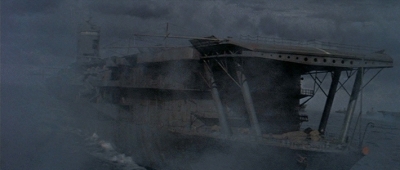
Whether they involve ancient galleys hurling balls of Greek Fire or Second World War battleships with blazing guns, naval scenes are usually filmed in a studio tank. The tank at 20th Century Fox studios in Hollywood, for example, is 360ft (110m) square. It was just for the Pearl Harbor sequences in Tora! Tora ! Tora! The effects supervisor, L.B. Abbott, won an Oscar for his work.
He explained: ‘To create the sequences where the Japanese fleet is seen battling a violent storm on its way to Pearl Harbor, we used just about every fan we could get our hands on.
‘To create foam for the storm-driven waves, it was necessary to add detergent to the water.
‘The conventional way of propelling models through a tank is to attach them to underwater cables. In the case of Tora! the models were fitted with engines from golf-carts. These worked satisfactorily in some scenes but were not suitable in the more violent storm sequences because the engines lacked sufficient power to drive the models through the tough water and we had to resort once again to cables.’
The giant ocean liner capsized by a huge wave in The Poseidon Adventure (1972) was a model. But for the chaotic scenes that ensued in the ship’s dining salon, a huge set was built. It could tit 30 degrees, while tilting cameras completed the illusion of the capsize. For the scenes in which the room appeared upside down, the same set was reversed from floor to ceiling.
Picture Credit : Google

